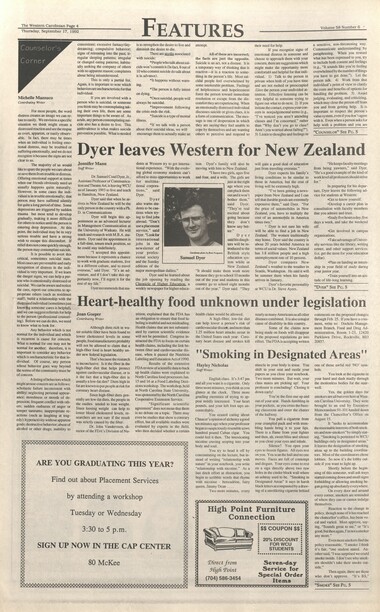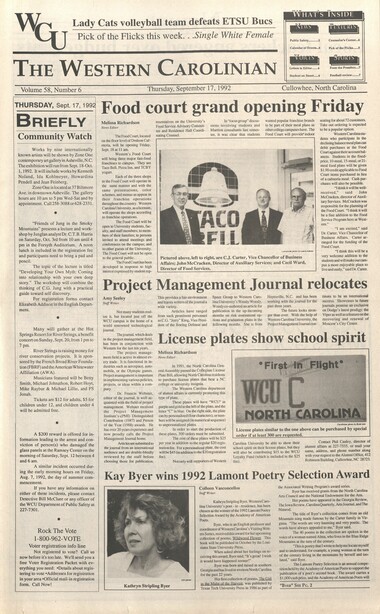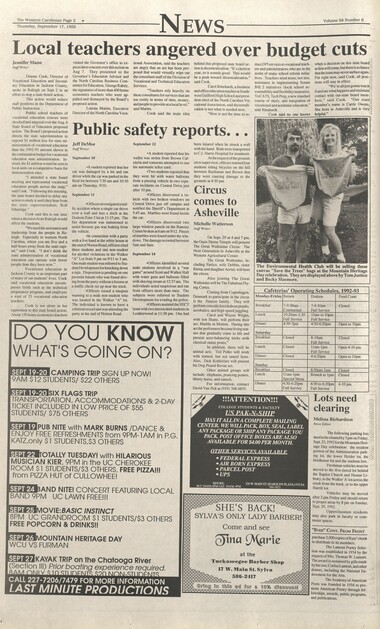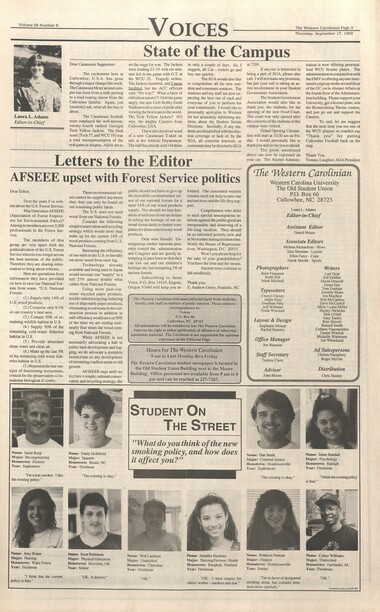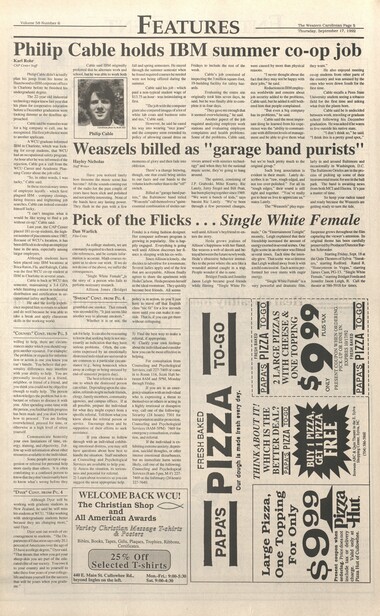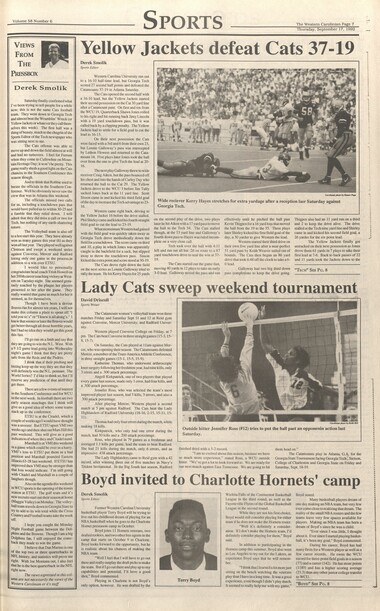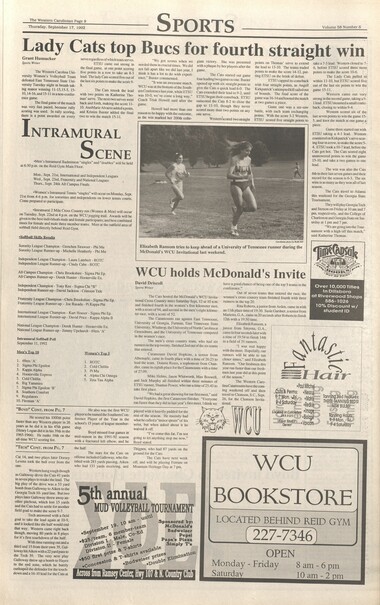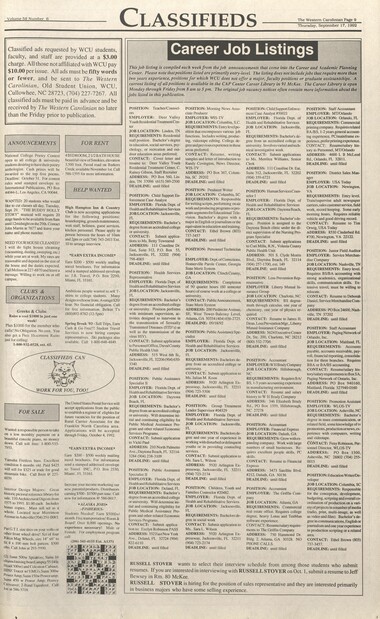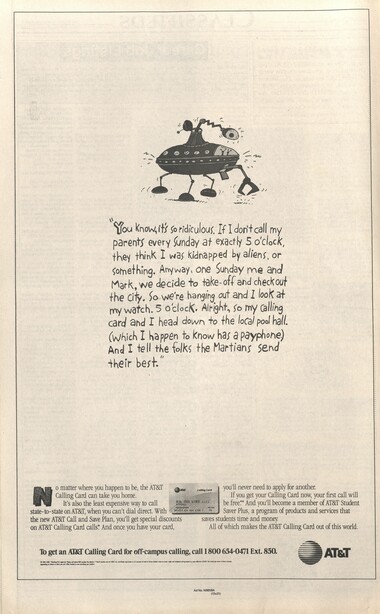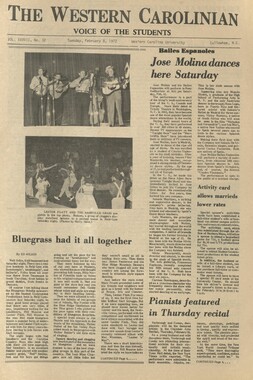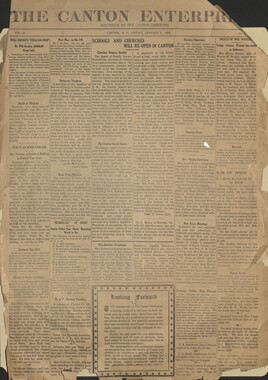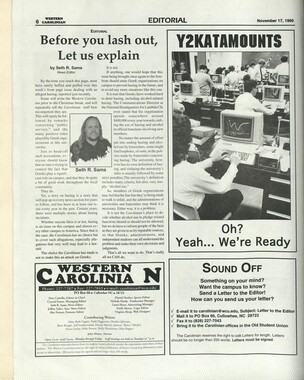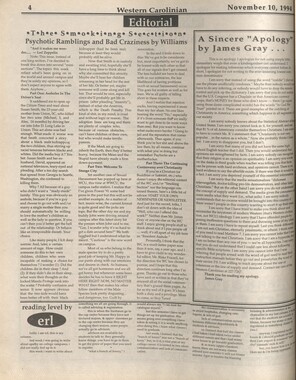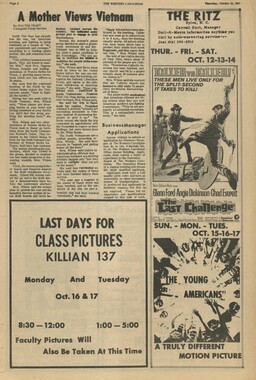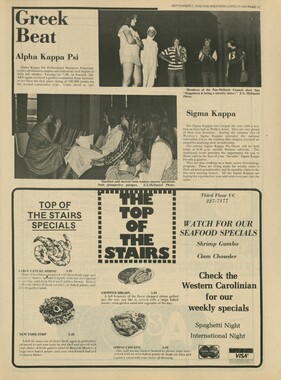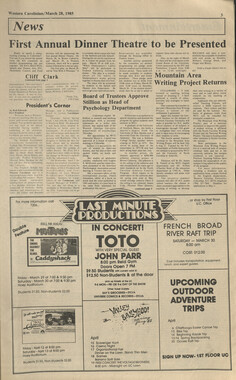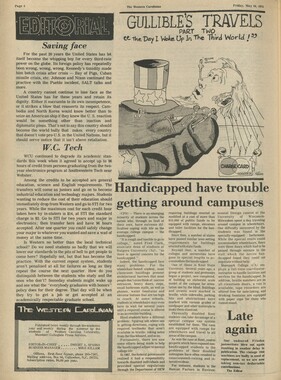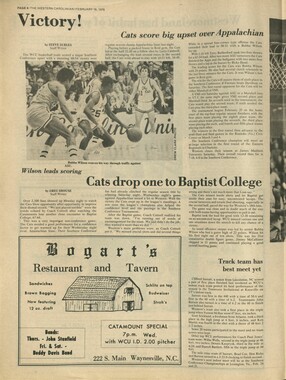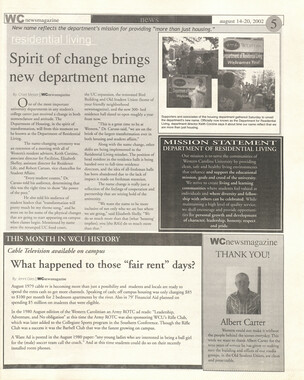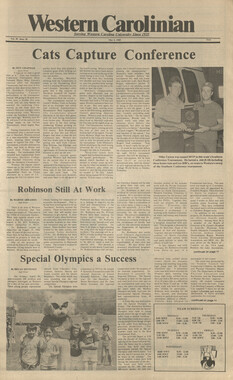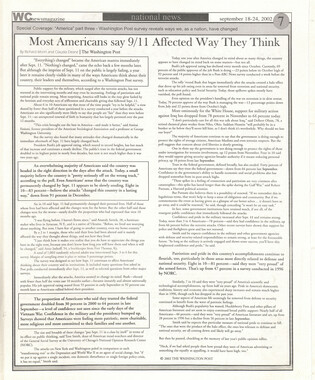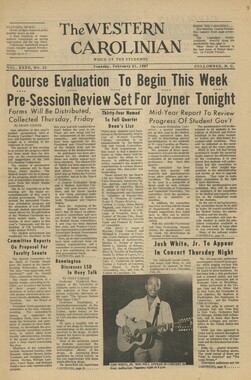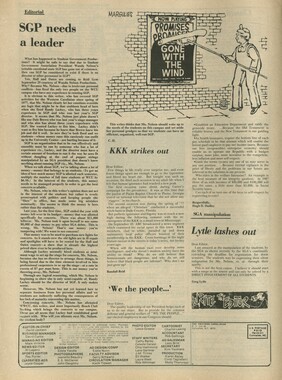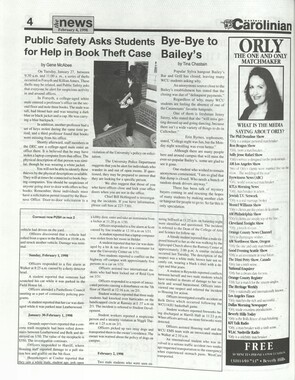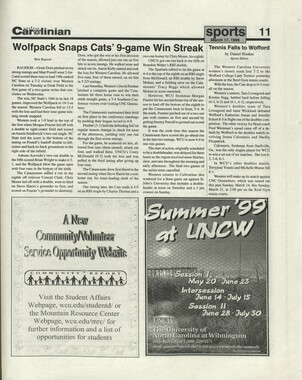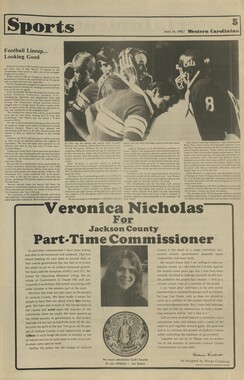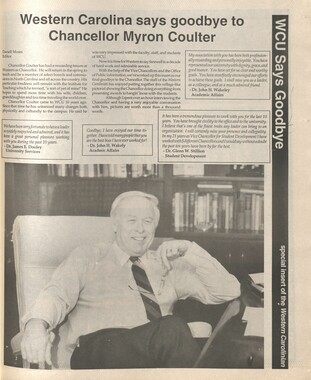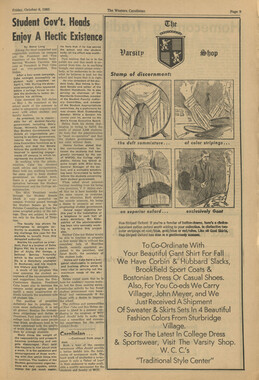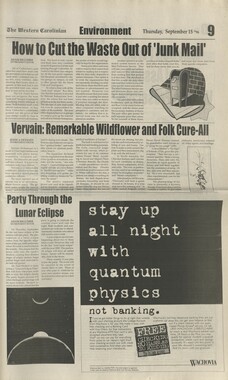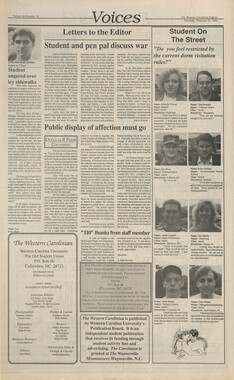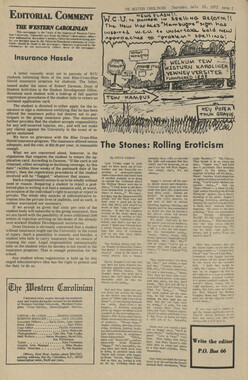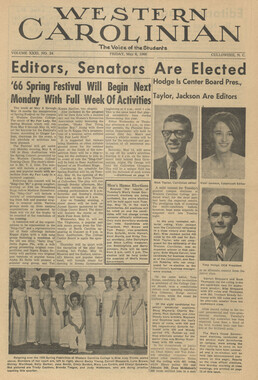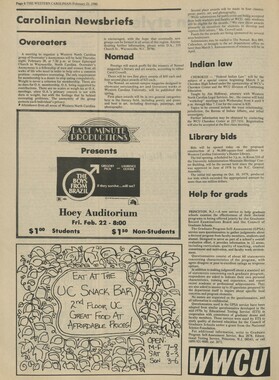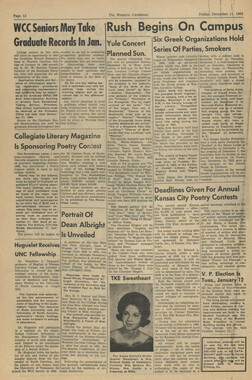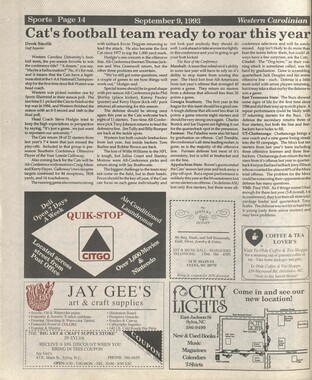Western Carolina University (20)
View all
- Canton Champion Fibre Company (2308)
- Cherokee Traditions (293)
- Civil War in Southern Appalachia (165)
- Craft Revival (1942)
- Great Smoky Mountains - A Park for America (2767)
- Highlights from Western Carolina University (430)
- Horace Kephart (941)
- Journeys Through Jackson (154)
- LGBTQIA+ Archive of Jackson County (26)
- Oral Histories of Western North Carolina (314)
- Picturing Appalachia (6772)
- Stories of Mountain Folk (413)
- Travel Western North Carolina (160)
- Western Carolina University Fine Art Museum Vitreograph Collection (129)
- Western Carolina University Herbarium (92)
- Western Carolina University: Making Memories (708)
- Western Carolina University Publications (2283)
- Western Carolina University Restricted Electronic Theses and Dissertations (146)
- Western North Carolina Regional Maps (71)
- World War II in Southern Appalachia (131)
University of North Carolina Asheville (6)
View all
- Allanstand Cottage Industries (62)
- Appalachian National Park Association (53)
- Bennett, Kelly, 1890-1974 (1388)
- Berry, Walter (76)
- Brasstown Carvers (40)
- Carver, George Washington, 1864?-1943 (26)
- Cathey, Joseph, 1803-1874 (1)
- Champion Fibre Company (233)
- Champion Paper and Fibre Company (297)
- Cherokee Indian Fair Association (16)
- Cherokee Language Program (22)
- Crowe, Amanda (40)
- Edmonston, Thomas Benton, 1842-1907 (7)
- Ensley, A. L. (Abraham Lincoln), 1865-1948 (275)
- Fromer, Irving Rhodes, 1913-1994 (70)
- George Butz (BFS 1907) (46)
- Goodrich, Frances Louisa (120)
- Grant, George Alexander, 1891-1964 (96)
- Heard, Marian Gladys (60)
- Kephart, Calvin, 1883-1969 (15)
- Kephart, Horace, 1862-1931 (313)
- Kephart, Laura, 1862-1954 (39)
- Laney, Gideon Thomas, 1889-1976 (439)
- Masa, George, 1881-1933 (61)
- McElhinney, William Julian, 1896-1953 (44)
- Niggli, Josephina, 1910-1983 (10)
- North Carolina Park Commission (105)
- Osborne, Kezia Stradley (9)
- Owens, Samuel Robert, 1918-1995 (11)
- Penland Weavers and Potters (36)
- Roberts, Vivienne (15)
- Roth, Albert, 1890-1974 (142)
- Schenck, Carl Alwin, 1868-1955 (1)
- Sherrill's Photography Studio (2565)
- Southern Highland Handicraft Guild (127)
- Southern Highlanders, Inc. (71)
- Stalcup, Jesse Bryson (46)
- Stearns, I. K. (213)
- Thompson, James Edward, 1880-1976 (226)
- United States. Indian Arts and Crafts Board (130)
- USFS (683)
- Vance, Zebulon Baird, 1830-1894 (1)
- Weaver, Zebulon, 1872-1948 (58)
- Western Carolina College (230)
- Western Carolina Teachers College (282)
- Western Carolina University (1794)
- Western Carolina University. Mountain Heritage Center (18)
- Whitman, Walt, 1819-1892 (10)
- Wilburn, Hiram Coleman, 1880-1967 (73)
- Williams, Isadora (3)
- Cain, Doreyl Ammons (0)
- Crittenden, Lorraine (0)
- Rhodes, Judy (0)
- Smith, Edward Clark (0)
- Appalachian Region, Southern (2399)
- Asheville (N.C.) (1917)
- Avery County (N.C.) (26)
- Blount County (Tenn.) (161)
- Buncombe County (N.C.) (1671)
- Cherokee County (N.C.) (283)
- Clay County (N.C.) (555)
- Graham County (N.C.) (233)
- Great Smoky Mountains National Park (N.C. and Tenn.) (510)
- Haywood County (N.C.) (3522)
- Henderson County (N.C.) (70)
- Jackson County (N.C.) (4692)
- Knox County (Tenn.) (25)
- Knoxville (Tenn.) (12)
- Lake Santeetlah (N.C.) (10)
- Macon County (N.C.) (420)
- Madison County (N.C.) (211)
- McDowell County (N.C.) (39)
- Mitchell County (N.C.) (132)
- Polk County (N.C.) (35)
- Qualla Boundary (981)
- Rutherford County (N.C.) (76)
- Swain County (N.C.) (2113)
- Transylvania County (N.C.) (247)
- Watauga County (N.C.) (12)
- Waynesville (N.C.) (73)
- Yancey County (N.C.) (72)
- Aerial Photographs (3)
- Aerial Views (60)
- Albums (books) (4)
- Articles (1)
- Artifacts (object Genre) (228)
- Bibliographies (1)
- Biography (general Genre) (2)
- Cards (information Artifacts) (38)
- Clippings (information Artifacts) (191)
- Crafts (art Genres) (622)
- Depictions (visual Works) (21)
- Design Drawings (1)
- Drawings (visual Works) (184)
- Envelopes (73)
- Facsimiles (reproductions) (1)
- Fiction (general Genre) (4)
- Financial Records (12)
- Fliers (printed Matter) (67)
- Glass Plate Negatives (381)
- Guidebooks (2)
- Internegatives (10)
- Interviews (812)
- Land Surveys (102)
- Letters (correspondence) (1013)
- Manuscripts (documents) (619)
- Maps (documents) (177)
- Memorandums (25)
- Minutes (administrative Records) (59)
- Negatives (photographs) (5835)
- Newsletters (1285)
- Newspapers (2)
- Occupation Currency (1)
- Paintings (visual Works) (1)
- Pen And Ink Drawings (1)
- Periodicals (193)
- Personal Narratives (10)
- Photographs (12976)
- Plans (maps) (1)
- Poetry (7)
- Portraits (1960)
- Postcards (329)
- Programs (documents) (151)
- Publications (documents) (2237)
- Questionnaires (65)
- Scrapbooks (282)
- Sheet Music (2)
- Slides (photographs) (402)
- Songs (musical Compositions) (2)
- Sound Recordings (796)
- Specimens (92)
- Speeches (documents) (15)
- Tintypes (photographs) (8)
- Transcripts (322)
- Video Recordings (physical Artifacts) (23)
- Vitreographs (129)
- Text Messages (0)
- A.L. Ensley Collection (275)
- Appalachian Industrial School Records (7)
- Appalachian National Park Association Records (336)
- Axley-Meroney Collection (2)
- Bayard Wootten Photograph Collection (20)
- Bethel Rural Community Organization Collection (7)
- Blumer Collection (5)
- C.W. Slagle Collection (20)
- Canton Area Historical Museum (2110)
- Carlos C. Campbell Collection (282)
- Cataloochee History Project (65)
- Cherokee Studies Collection (4)
- Daisy Dame Photograph Album (5)
- Daniel Boone VI Collection (1)
- Doris Ulmann Photograph Collection (112)
- Elizabeth H. Lasley Collection (1)
- Elizabeth Woolworth Szold Fleharty Collection (4)
- Frank Fry Collection (95)
- George Masa Collection (173)
- Gideon Laney Collection (452)
- Hazel Scarborough Collection (2)
- Hiram C. Wilburn Papers (28)
- Historic Photographs Collection (236)
- Horace Kephart Collection (861)
- Humbard Collection (33)
- Hunter and Weaver Families Collection (1)
- I. D. Blumenthal Collection (4)
- Isadora Williams Collection (4)
- Jesse Bryson Stalcup Collection (47)
- Jim Thompson Collection (224)
- John B. Battle Collection (7)
- John C. Campbell Folk School Records (80)
- John Parris Collection (6)
- Judaculla Rock project (2)
- Kelly Bennett Collection (1407)
- Love Family Papers (11)
- Major Wiley Parris Civil War Letters (3)
- Map Collection (12)
- McFee-Misemer Civil War Letters (34)
- Mountain Heritage Center Collection (4)
- Norburn - Robertson - Thomson Families Collection (44)
- Pauline Hood Collection (7)
- Pre-Guild Collection (2)
- Qualla Arts and Crafts Mutual Collection (12)
- R.A. Romanes Collection (681)
- Rosser H. Taylor Collection (1)
- Samuel Robert Owens Collection (94)
- Sara Madison Collection (144)
- Sherrill Studio Photo Collection (2558)
- Smoky Mountains Hiking Club Collection (616)
- Stories of Mountain Folk - Radio Programs (374)
- The Reporter, Western Carolina University (510)
- Venoy and Elizabeth Reed Collection (16)
- WCU Gender and Sexuality Oral History Project (32)
- WCU Mountain Heritage Center Oral Histories (25)
- WCU Oral History Collection - Mountain People, Mountain Lives (71)
- WCU Students Newspapers Collection (1744)
- Western North Carolina Tomorrow Black Oral History Project (69)
- William Williams Stringfield Collection (2)
- Zebulon Weaver Collection (109)
- African Americans (390)
- Appalachian Trail (35)
- Artisans (521)
- Cherokee art (84)
- Cherokee artists -- North Carolina (10)
- Cherokee language (21)
- Cherokee pottery (101)
- Cherokee women (208)
- Church buildings (167)
- Civilian Conservation Corps (U.S.) (110)
- College student newspapers and periodicals (1830)
- Dams (103)
- Dance (1023)
- Education (222)
- Floods (61)
- Folk music (1015)
- Forced removal, 1813-1903 (2)
- Forest conservation (220)
- Forests and forestry (1058)
- Gender nonconformity (4)
- Great Smoky Mountains National Park (N.C. and Tenn.) (181)
- Hunting (38)
- Landscape photography (10)
- Logging (103)
- Maps (84)
- Mines and mineral resources (8)
- North Carolina -- Maps (18)
- Paper industry (38)
- Postcards (255)
- Pottery (135)
- Railroad trains (71)
- Rural electrification -- North Carolina, Western (3)
- School integration -- Southern States (2)
- Segregation -- North Carolina, Western (5)
- Slavery (5)
- Sports (452)
- Storytelling (245)
- Waterfalls -- Great Smoky Mountains (N.C. and Tenn.) (66)
- Weaving -- Appalachian Region, Southern (280)
- Wood-carving -- Appalachian Region, Southern (328)
- World War, 1939-1945 (173)
Western Carolinian Volume 58 Number 06
Item
Item’s are ‘child’ level descriptions to ‘parent’ objects, (e.g. one page of a whole book).
-
-
The Western Carolinian Page 4 Thursday, September 17, 1992 Features Volume 58 Number 6 Michelle Mazzuco Contributing Writer For most people, the word distress creates an image we can relate to easily. We envision a specific situation we think might create a distressed reaction and see the respse as overt, apparent, or easily observable. In fact, there may be times when an individual is feeling emotional distress, may be troubled or suffering emotionally, and we do not recognize it because the signs are not clear to us. The majority of us would like to spare the people we care about or save them from trouble or distress. Offering emotional support at times when our friends obviously need us usually happens quite naturally. However, in some cases the individual is in trouble emotionally; that person may have suffered silendy for quite a long period of time. Some depressions are triggered by sudden trauma but most tend to develop gradually, making it more difficult for others to notice until the person is entering deep depression. At this point, the individual may be in very serious trouble and have a strong wish to escape this discomfort. If relief does not come quickly enough, the person may contemplate suicide. It is possible to avert this critical, sometimes suicidal state. Most cases are preventable and early recognition of distress in the individual is very important. If we learn the danger signs, we can help a person who is emotionally distressed or suicidal. We can be aware and notice the cues, report our concerns to appropriate others (such as residence staff), build a relationship with the distressed individual (sometimes just knowing someone cares is helpful), and we can suggest referrals for help to the person (professional counseling). Before we can do this, we need to know what to look for. Any behavior which is not normal for the individual and which is recurrent is cause for concern. What is normal for one may not be normal for another; therefore, it is important to consider any behavior which is uncharacteristic for that individual. Of course, any person whose behavior goes way beyond the norms of the community must be of concern. A listing of behaviors which might arouse concern are as follows: scholastic failure inconsistent with ability; neglecting personal appearance; moodiness or moods of depression; frequent conflict with others; sudden outbursts of anger or temper tantrums; inappropriate reactions (such as laughing at tragedy); hyperactivity without apparent goals; destructive behavior; abuse of alcohol or other drugs; inability to concentrate; excessive fantasy/daydreaming; compulsive behavior; signs of retreating into the past; irregular sleeping patterns; irregular or changed eating patterns; habitually seeking the company of others with no apparent reason; complaints about being misunderstood. This is only a partial list. Again, it is important to note which behaviors are uncharacteristic for that individual. If you are involved with a person who is suicidal, or someone you think may be contemplating taking their own life, there are some important things to be aware of. As a rule, any person contemplating suicide also has a desire to live. This ambivalence is what makes suicide prevention possible. What is needed is to strengthen the desire to live and diminish the desire to die. There are myths associated with suicide: ♦People who talk aboutsui- cide won't commit it (In fact, 8 out of 10 who commit suicide do talk about it in advance). *It happens without warning. *The person is fully intent on dying. *Once suicidal, people will always be suicidal. ♦Improvement following the crisis ends the risk. ♦Suicide is a type of mental illness. ♦If we talk with a person about their suicidal ideas, we will encourage them to actually make an attempt. All of these are incorrect; the facts are just the opposite. Suicide is an act, not a disease. It is a temporary way of thinking that is reactive—it is a reaction to something in the person's life. Most suicidal people feel overwhelmed by some intolerable problem. Feelings of helplessness and hopelessness force the person toward immediate resolution or escape from the discomfort they are experiencing. When an emotionally distressed individual discusses suicide or gives clues, it is a form of communication. Themes- sage is one of desperation in which they are saying" they feel unable to cope by themselves and are wanting others to perceive and respond to their need for help. If you recognize signs of emotional distress in someone and choose to approach them with your concern, there are suggestions which might make die opportunity more comfortabl and helpful for that individual. 1) Talk to the person in private when both of you have time and are not rushed or preoccupied .Give the person your undivided attention. Effective listening can be very helpful to someone trying to figure out what to do next. 2) If you initiate the contact, express your concern in nonjudgemental terms (e.g., "I've noticed you aren't attending classes and I'm concerned." rather than "Why don't you go to class? Aren't you worried about failing?"). 3) Listen to thoughts and feelings in a sensitive, non-threatening way. Communicate understanding by paraphrasing. When you reword what has been expressed to you, try to include both content and feelings (e.g., "It sounds like you're feeling overwhelmed by thenumberof things you have to get done."). Let the person talk. 4) Work from that individual's point of view to clarify the costs and benefits of options for handling the problem. 5) Avoid judging, evaluating, and criticizing, which may close the person off from you and from getting help. It-is important to respect the person's value system, even if you don' tagree with it. Even when a person asks for help with a problem and you are "Counselor" See Pg. 5 Dyer leaves Western for New Zealand Jennifer Mann StaffWriter Dr. Samuel Coad Dyer, Jr., Assistant Professor of Communication and Theatre Art, is leaving WCU as of January 1993 to live and teach in Hamilton, New Zealand. Dyer said that when he arrives in New Zealand he will be the only person in the country with a Ph. D. in Communications Dyer will begin this appointment as an advanced lecturer in Management Communication at the University of Waikato. He will teach and research with M.B.A. students. Dyer said the appointment is a full-time, tenure track position, so he could stay indefinitely. "1 accepted this appointment because it represents a chance to work with graduate students, live in a different culture, and to travel overseas," said Dyer. "It's an adventure, and if I don't take this opportunity now, I'll regret it for the rest of my life." Dyer recommends that stu dents at Western try to get international experience. "With the evolving global economy students can't afford to miss opportunities to work for multinational corporations," said Dyer. Dyer also warns students to be cautious when trying to find jobs abroad. "Don't use a placement service," said Dyer. "Look for international jobs in the newsletter of your professional society and the Sunday editions of the major metropolitan dailies." Dyer said he learned about the job opening by reading the Chronicle of Higher Education, a weekly newspaper for higher educa tion. Dyer's family will also be moving with him to New Zealand. "I have two girls, ages five and four, and a wife. The girls are just at the right age where you can pluck them out and itwon't bother them," said Dyer. "They're real excited about going because they don't know any better." Dyer said his daughters will be introduced to the British style education system while in New Zealand. "It should make them work more because they go to school 10 months out of the year and students in this country go to school eight months out of the year," Dyer said. "They Carolinusn photo by Brett Ferguson Samuel Dyer will gain a good deal of education just from traveling overseas." Dyer expects his family's living conditions to be similar to those in America, but the cost of living will be extremely high. "I've been getting a newspaper from New Zealand and 1 can tell that durable goods are extremely expensive there," said Dyer. "For the price of automobiles in New Zealand, you, have to multiply the cost of an automobile in America times two." ' Dyer is not sure his wife will be able to find a job in New Zealand. The women traditionally stay home. Dyer said the country is about 20 years behftid America in terms of social values. New Zealand has 3.8 million people and a high unemployment rate of 10 percent. Dyer compares New Zealand's weather to the weather in Seatde, Washington. He said it will be summer there when his family arrives in January. Dyer's favorite personality at WCU is Dr. Steve Ayers. "He keeps faculty meetings from being yawners," said Dyer. "He's a good example of the kind of work level all professors should strive for." In preparing for his departure, Dyer leaves the following advice for students at Western: •Get to know yourself. •Develop a career plan in consultation with faculty members that you admire and trust. •S tudy five hours a day, five days a week, and take the weekend off. •Get involved in campus organizations. •Take advantage of University services like the library, writing center, and other support services; (i.e. get the most for your education dollar). •Plan on landing an internship in your field of study during your junior year. •Train yourself into an attitude of life-long learning. "Dyer" See Pg. 5 Heart-healthy food unknown under legislation Joan Gosper Contributing Writer Although diets rich in water-soluble fiber have been found to lower cholesterol levels in some people, food manufacturers probably will not be allowed to claim that a high-fiber food is heart healthy under new federal legislation. That's because the research is inconclusive. Is it the fiber in the high-fiber diet that helps protect against cardiovascular disease, or is it the fact that a high-fiber diet is usually a low-fat diet? Diets high in fat are known to put people at risk for coronary heart disease. Since high-fiber diets generally are low-fat diets, the people in the studies tended to lose weight. Since loosing weight can help to lower blood cholesterol levels, researchers are not sure if the result was strictly caused by the fiber. Dr. John Vanderveen, director of the FDA's Division of Nu trition, explained that the FDA has an obligation to ensure that food labeling is truthful and not misleading. Health claims that are not substantiated by current scientific evidence will not be permitted. Congress instructed the FDA to focus on certain health claims, including the link between fiber and cardiovascular disease, when it passed the Nutrition Labeling and Education Act of 1990. Results of the extensive FDA review of scientific data to back up health claims were explained to North Carolina food processors Jan. 15 and 16 at a Food Labeling Decisions workshop. The workshop, held at North Carolina State University, was sponsored by the North Carolina Cooperative Extension Service. "Significant scientific agreement" does not mean that there is no debate on a topic. There may even be studies that show a contrary effect, but all available studies were evaluated by experts in the field, who then decided whether a certain health claim would be allowed. A high-fiber, low-fat diet can help lower a person's risk of cardiovascular disease, and more than 1.25 million heart attacks occur in the United States each year. Coronary heart disease and strokes kill nearly as many Americans as all other diseases combined. It is also a major cause of disability in this country. Some of the claims now being made on foods will disappear if the proposed regulations go into effect. The FDA is accepting written comments on the proposed changes through Feb. 25. If you have a comment, write to: Dockets Management Branch, Food and Drug Administration, Room 1-23, 12420 Parklawn Drive, Rockville, MD 20857. "Smoking in Designated Areas" S5«rSH$s:;^^^^^ xb Xb Twt xb xb xb xb xb xb :o Tii xb xb xb xb xb xb xb xb xb xb xb xb xb xb xb xb xb xb xb xb xb xb xb xb xb xb xb xb xb xb xb xb xb xb xb ARE YOU GRADUATING THIS YEAR? Find out about Placement Services by attending a workshop Tuesday or Wednesday 3:30 to 5 p.m. SIGN UP NOW IN THE CAP CENTER 80 McKee T'Y, CT CT CT cr, CT CT CT CT CT CT CT CT CT CT CT CT CT CT CT CT CT CT CT CT CT v CT CT CT CT CT CT CT CT CT CT CT CT CT CT CT CT CT CT CT CT CT Hayley Nicholas StaffWriter English class. It's 3:47 pm and all you want is a cigarette. Only three more minutes, you think as you glance at the clock. Three more grueling eternities of trying to appear mildly interested. Your heart pounds, and your left foot taps uncontrollably. You ceased caring about Chaucer's opinion of alchemy a good ten minutes ago when your professor began to suspiciously resemble a two hundred pound Cuban cigar. You could feel it then. The intoxicating nicotine craving seeping into your body and soul. You try to head it off by concentrating on die lecture, but instead of writing "relationship with nature" in your notebook, you write "relationship with nicotine." As a last ditch effort at distraction, you begin to scribble words that rhyme with nicotine - benzadrine, fairy queen, jimmy Dean .... Two more minutes, every muscle in your body is tense. You shift in your seat and rustle your papers as you close your notebook. Two more minutes. But wait, your class mates are picking up! Your professor is concluding! Closing it down early! You're the first one up and out of your seat. Hands fumbling in your pockets, as you cross the buzzing classroom and enter the chatter of the hallway. You pull a cigarette from your crumpled pack and with trembling hands bring it to ypur lips. There is a flame from your lighter and then, ah, sweet bliss and silence as you close your eyes and inhale. Silence? You open your eyes to frozen figures. All eyes rest on you. You scan the hal 1 and no one moves. Faces are full of contempt and disgust. Your eyes come to rest on a sign directly above two raw holes in the cinder block wall where an ashtray used to be. "Smoking in Designated Areas" it says in harsh black letters accompanied by a drawing of a smoldering cigarette behind mw* y 'wTyT«Tw'yTyTwTyTyTyTy*'•'TyTytuTuTyTyTwT~luTwTuTwTuTyTuT~TyTy^wWTyTyTufTyTyTyTyTyTyTyTyTyTyTwTuTuTyTyYyTyTyTyT^JTi Y'ylylylyTyTyTyTyTyTyTyTyTyluTyTyTyTyTyTyT High Point Furniture Connection : $$ COUPONI $$ j (Direct from ttigh "Point (704) 586-3454 20% DISCOUNT : FOR WCU STUDENTS : Seven-day Service for Special Order Items one of those awful red 'NO' symbols. You look at the cigarette in your hand and dash madly through the motionless bodies for the stairwell. Yes, the golden days for smokers are all but over here at West- em Carolina University. They were brought to an end by Executive Memorandum 91-101 handed down from the Chancellor's Office on August 15. It "seeks to accommodate the reasonable interests of both smokers and non-smokers" by simply stating, "Smoking is permitted in WCU buildings only in designated areas." It leaves the designation of smoking areas up to the building coordinators. Most of the coordinators chose lobbies. So now it's the lobby outside if you want to light up. Shordy before the beginning of this semester, wall ash trays started coming down and small signs forbidding or allowing smoking began going up absolutely everywhere. On every door and around every corner, smokers are reminded of where they can or cannot indulge themselves. Reaction to the change in policy, though none of it has reached the chancellor's office, has been vocal and varied. Most approve, saying, "Sounds great to me," or "It's good, but then again, I'm notasmoker any more." Even most smokers find the policy reasonable. "I smoke: I think it's fair, "one student stated. Another said, "I was surprised we could smoke inside. I don't see why smokers shouldn't take their smoke outside." Then again, there are those who don't approve. "It's BS," "Smoke" See Pg. 5
Object
Object’s are ‘parent’ level descriptions to ‘children’ items, (e.g. a book with pages).
-
The Western Carolinian is Western Carolina University's student-run newspaper. The paper was published as the Cullowhee Yodel from 1924 to 1931 before changing its name to The Western Carolinian in 1933.
-
